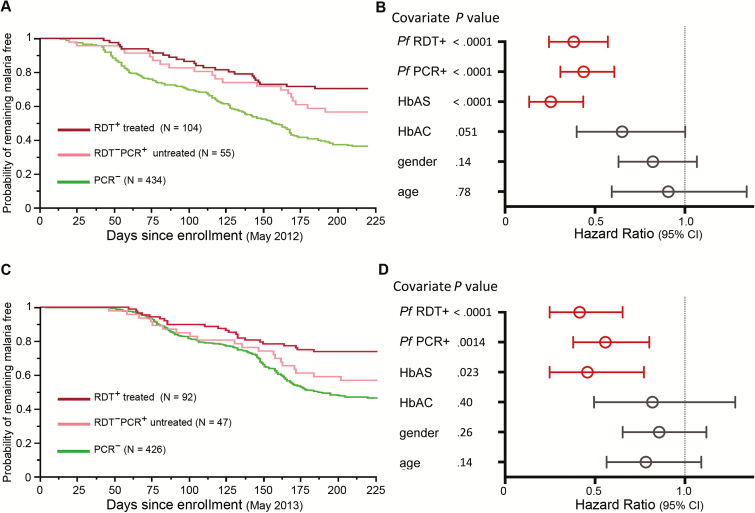Figure 3.
Treatment of chronic asymptomatic Plasmodium falciparum infection does not change the subsequent risk of febrile malaria. A, Kaplan-Meier analysis of time to first febrile malaria episode during the 2012 malaria season stratified by P. falciparum infection and treatment status at the end of the dry season in May 2012. Pairwise comparisons by log-rank test: RDT+/treated vs PCR– (P < .0001); RDT–PCR+/untreated vs PCR– (P < .0001); RDT+/treated vs RDT–PCR+/untreated (P = .26). B, Cox model showing the effect of P. falciparum infection and treatment status in May 2012 on the risk of febrile malaria during the ensuing 2012 malaria season, adjusted for covariates. C, Kaplan-Meier analysis of time to first febrile malaria episode during the 2013 malaria season stratified by P. falciparum infection and treatment status at the end of the dry season in May 2012. Pairwise comparisons by log-rank test: RDT+/treated vs PCR– (P < .0001); RDT–PCR+/untreated vs PCR– (P < .0001); RDT+/treated vs RDT–PCR+/untreated (P = .066). D, Cox model showing the effect of P. falciparum infection and treatment status in May 2012 on the risk of febrile malaria during the 2013 malaria season, adjusted for covariates. Hazard ratios and 95% confidence intervals are represented by open circles and horizontal bars, respectively. Abbreviations: CI, confidence interval; HbAC, hemoglobin type AC; HbAS, hemoglobin type AS; PCR, polymerase chain reaction; Pf, Plasmodium falciparum; RDT, rapid diagnostic test.

